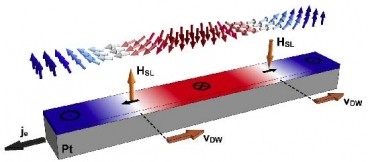A magnetic phenomenon newly discovered by MIT researchers could lead to much faster, denser and more energy-efficient chips for memory and computation.
The findings, reported in the journal Nature Materials, could reduce the energy needed to store and retrieve one bit of data by a factor of 10,000, says the paper’s senior author, Geoffrey Beach, an assistant professor of materials science and engineering at MIT. The paper’s co-authors are graduate students Satoru Emori and Uwe Bauer, postdoc Sung-Min Ahn, and Eduardo Martinez of the University of Salamanca in Spain.
Beach says that hints of the new phenomenon have been reported for several years, but these had remained unexplained until now. The new results could overcome “a lot of what had seemed like fundamental limitations” in the control and use of magnetic materials, he says, adding: “It’s a whole new approach to the design of magnetic materials.”
It turns out the key to this phenomenon lies not in the magnetic materials themselves, but in what’s next to them: In this case, the team used very thin films of a ferromagnetic material, deposited on a metal base, and with a layer of an oxide material on top — a sort of ferromagnet sandwich. The behavior of the ferromagnetic layer, it turns out, depends on the metal that layer rests upon.
Ferromagnetic materials, including the familiar bar magnets, have a north and a south pole. When such materials are used for data storage, such as on a computer’s hard disk, separate tiny “domains” on their surface can have these poles pointing either up or down, representing ones and zeros. Normally, when a ferromagnetic material is exposed to a current, these domains are pushed along the surface in the same direction as the electron flow.
But previously, in rare cases, the movement was in the opposite direction, puzzling researchers. The MIT team found that when the thin ferromagnetic film was deposited on a slab of platinum, it exhibited this backward flow — which Beach likens to being dragged upwind.
But under circumstances that were identical, except that the film was deposited on the metal tantalum, the magnetic domains flowed in the normal direction — meaning that the key was not in the ferromagnet itself, but in its next-door neighbor. Both platinum and tantalum are nonmagnetic, so they would not ordinarily be expected to affect magnetic behavior.
It turns out that in either case, an unexpected effect alters how magnetic domains switch from one orientation to the other. Normally, when the spin orientation changes from one domain to the other (say, from “up” to “down”), the direction of that change is random. But in these thin-film sandwiches, spin rotations are aligned, consistently either turning clockwise or counterclockwise. The researchers showed that because of this peculiar effect, current can push domains with much more force than in conventional materials, and the direction that the domains move can be engineered simply by selecting the nonmagnetic metal underneath the magnet.
Such asymmetrical behavior is called a chiral effect; the researchers say this is the first demonstration of chiral behavior in magnetic domains.
“There are very few systems in nature that have this preferred way to rotate,” Beach says. Among the few are the molecules that form the basis for life, such as those that assemble into DNA molecules. Additionally, a few magnetic materials have shown this property, “but only in very exotic structures,” he says: at temperatures just slightly above absolute zero, and only in a perfect single crystal.
The new phenomenon, by contrast, is seen “at room temperature and well above room temperature, and in devices that are ideally suited for integration into electronic devices,” Beach says.
In the new ferromagnetic sandwiches, the forces pushing the magnetic domains are 100 times greater than in conventional ferromagnetic storage systems. Since the power needed to move the domains varies with the square of these forces, Beach says, such a system could be 10,000 times more efficient than existing technology.
With that, “all of a sudden these go from just looking interesting to being competitive even with very entrenched technology,” Beach says. And because these structures are compatible with existing manufacturing methods, he predicts, “these things are going to be out there and making a difference very soon.”
Emori, the paper’s lead author, says that there are now several kinds of memory systems, from the ones within a computer’s internal memory to those on hard disks or solid-state USB thumb drives. Theoretically, by harnessing these new effects, he says, “all of these could be satisfied by one material.”
This is “a very important, major advance,” says Robert Buhrman, a professor of engineering and senior vice provost for research at Cornell University. The MIT research, he says, is part of “a very intense effort worldwide to efficiently control the motion of ferromagnetic domain walls in thin-film nanostructures for future very high-performance data-storage and nonvolatile logic operations.”
Buhrman adds, “This work has answered several important questions raised by earlier studies as to how a current pulse can very rapidly move domain walls in a preferred direction.” Besides providing those answers, he says, it “raises new questions for follow-on work.”
“It’s really a whole new class of magnetic materials,” Beach says. “It opens up possibilities that it would have been difficult to even speculate about a couple of years ago.”
The work was supported in part by the National Science Foundation.


